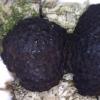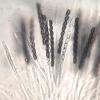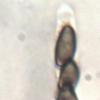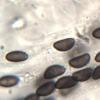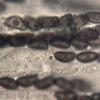
04-11-2025 09:07
Hello.A suspected Hymenoscyphus sprouting on a thi

04-11-2025 12:43
 Edvin Johannesen
Edvin Johannesen
Hi! One more found on old Populus tremula log in O

03-11-2025 21:34
 Edvin Johannesen
Edvin Johannesen
These tiny (0.4-0.5 mm diam.), whitish, short-stip

28-10-2025 15:37
Carl FarmerI'd be grateful for any suggestions for this strik

03-11-2025 16:30
 Hans-Otto Baral
Hans-Otto Baral
Hello I want to ask you if you have found this ye
Hypoxylon (?) on chestnut
Lepista Zacarias,
04-07-2016 23:41
I found this stromatic fungus growing on the wood of _Castanea sativa_. The stroma is brown and exsudes a red pigment in KOH. The asci are very long
and thin, up to 150 x 6 µm, unitunicate, apically amyloid, and contain 8-spores each, uniserially arranged at the top. The spores are one-celled, hyaline when
young and soon brown, guttulate, with the following dimensions:
(6.7) 6.9 - 7.7 (8.1) × (3.3) 3.5 - 4.1 µm
Q = (1.8) 1.81 - 2.1 (2.2) ; N = 27
Me = 7.4 × 3.8 µm ; Qe = 1.9 ,
which are much smaller than my previous observations of similar fungi. Can someone help me in give it a name?
Thanks in advance,
zaca
Jacques Fournier,
05-07-2016 08:29

Re : Hypoxylon (?) on chestnut
Hi Zaca,
it fits well Annulohypoxylon minutellum, formerly known as Hypoxylon cohaerens var. microsporum.
Jacques
it fits well Annulohypoxylon minutellum, formerly known as Hypoxylon cohaerens var. microsporum.
Jacques
Lepista Zacarias,
05-07-2016 14:23
Re : Hypoxylon (?) on chestnut
Merci, Jacques!
The size of the spores troubled me.
Best wishes,
zaca
The size of the spores troubled me.
Best wishes,
zaca
Paul LEROY,
06-07-2016 11:58
Re : Hypoxylon (?) on chestnut
Bonjour Zacaria et Jacques,
D'accord pour Annulohypoxylon minutellum mais le support m'intrigue. J'ai souvent récolté cette espèce mais toujours sur Quercus sp.
Amicalement
Paul
D'accord pour Annulohypoxylon minutellum mais le support m'intrigue. J'ai souvent récolté cette espèce mais toujours sur Quercus sp.
Amicalement
Paul
Thomas Læssøe,
06-07-2016 14:15
Re : Hypoxylon (?) on chestnut
Castanea and Quercus are closely related genera that share several other ± saprotrophic fungi so not so surprising to find Annulohypoxylon minutellum also on Castanea
cheers
cheers
Lepista Zacarias,
06-07-2016 14:47
Re : Hypoxylon (?) on chestnut
Thanks to Paul and to Thomas for their messages.
After the proposal of Jacques, I looked for more information about this species and in the description of Hypoxylon cohaerens at the webpage "Pyrenomycetes from southwestern France"
http://pyrenomycetes.free.fr/hypoxylon/html/Hypoxylon_cohaerens.htm
I found the following text that I quote:
"Notes: Hypoxylon cohaerens is a common saprophyte of beech forests, characterized by black pulvinate stromata constricted at base with papillate ostioles. Two other taxa, H. cohaerens var. microsporum and H. multiforme, share similar stromatal features, and field identification relies mainly on host identification: H. cohaerens is restricted to Fagus while H. cohaerens var. microsporum is restricted to Quercus and Castanea and H. multiforme grows mostly on Betula, Alnus and Corylus. However, one collection made on Ligustrum vulgare, a member of Oleaceae, [Hautes Pyrénées (65), Bagnères de Bigorre, L'Arbizon, 04 Sept. 2002, JF-02154, leg. FC] proves that host specificity is rarely absolute."
From it I infer that Castanea sativa is a common host for Annulohypoxylon minutellum (formerly known as Hypoxylon cohaerens var. microsporum, as Jacques mentioned). Am I wrong?
Best wishes,
zaca
After the proposal of Jacques, I looked for more information about this species and in the description of Hypoxylon cohaerens at the webpage "Pyrenomycetes from southwestern France"
http://pyrenomycetes.free.fr/hypoxylon/html/Hypoxylon_cohaerens.htm
I found the following text that I quote:
"Notes: Hypoxylon cohaerens is a common saprophyte of beech forests, characterized by black pulvinate stromata constricted at base with papillate ostioles. Two other taxa, H. cohaerens var. microsporum and H. multiforme, share similar stromatal features, and field identification relies mainly on host identification: H. cohaerens is restricted to Fagus while H. cohaerens var. microsporum is restricted to Quercus and Castanea and H. multiforme grows mostly on Betula, Alnus and Corylus. However, one collection made on Ligustrum vulgare, a member of Oleaceae, [Hautes Pyrénées (65), Bagnères de Bigorre, L'Arbizon, 04 Sept. 2002, JF-02154, leg. FC] proves that host specificity is rarely absolute."
From it I infer that Castanea sativa is a common host for Annulohypoxylon minutellum (formerly known as Hypoxylon cohaerens var. microsporum, as Jacques mentioned). Am I wrong?
Best wishes,
zaca
Lothar Krieglsteiner,
06-07-2016 15:17

Re : Hypoxylon (?) on chestnut
Hi together,
what grows on Quercus also grows on Castanea. There is no fungus I know (mycorhizal or saprotrophic) growing with/on Quercus that does not grow with/on Castanea. Example: even the typical Castanea-fungus Rutstroemia echinophila can be found on Quercus leaves and cupules.
Regards from Lothar
Lepista Zacarias,
06-07-2016 20:39
Re : Hypoxylon (?) on chestnut
Thanks, Lothar, for your opinion.
Best wishes,
zaca
Best wishes,
zaca


